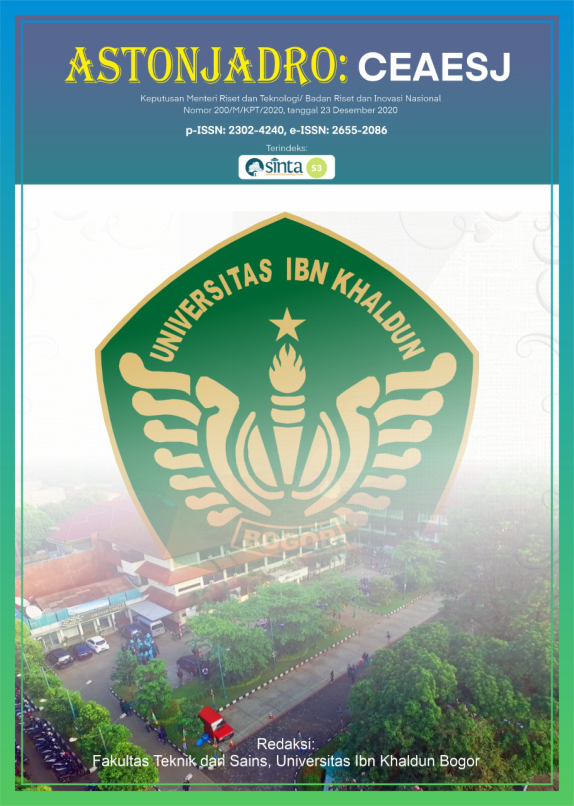EVALUATION OF WASTEWATER TREATMENT IN NUSA DUA TOURISM AREA AND THEIR CHALLENGES TO ALGAE BLOOM
DOI:
https://doi.org/10.32832/astonjadro.v10i2.5413Keywords:
wastewater, organic, nutrient, alge, reservoir, treatment.Abstract
The wastewater treatment plant (WWTP) in the Nusa Dua area has implemented a stabilization pond to reduce organic matter and nutrients. Because it has been operating since 1980, it is necessary to evaluate the existing conditions. The aim of this study was to determine the percentage of organic and nutrient reduction from the WWTP system. Organic removal in the form of BOD and COD parameters were 71.84% and 75.11%, respectively. Meanwhile, nutrient parameters in the form of NH3-N, TN, and TP have a percentage of 83.64%; 59.41%, and -375.81%, respectively. TP is the only parameter that has increased, causing a problem which is caused by the explosion of algae population in the reservoir. TP allowance should be a concern in choosing advanced treatment.
References
Afifah, A. S., Suryawan, I. W. K., & Sarwono, A. (2020). Microalgae production using photo-bioreactor with intermittent aeration for municipal wastewater substrate and nutrient removal. Communications in Science and Technology, 5(2), 107-111.
Afifah, A. S., Suryawan, I. W. K., Apritama, M. R., Prajati, G., & Adicita, Y. (2019, October). Kinetics of organic and nutrient degradation with microalgae biomass cultured in photobioreactors. In 2019 2nd International Conference on Applied Engineering (ICAE) (pp. 1-4). IEEE.
Ariesyady, H. D., Fadilah, R., Kurniasih., Sulaeman, A & Kardena, E. (2016). The Distribution of Microalgae in a Stabilization Pond System of a Domestic Wastewater Treatment Plant in a Tropical Environment (Case Study: Bojongsoang Wastewater Treatment Plant). J. Eng. Technol. Sci., vol. 48, no. 1, pp. 86 – 98.
Chen, X., He, S., Huang, Y., Kong, H., Lin, Y., Li, C., & Zeng, G. (2009). Laboratory investigation of reducing two algae from eutrophic water treated with light-shading plus aeration. Chemosphere, 76(9), 1303-1307.
Chen, X., Kong, H., He, S., Wu, D., Li, C., & Huang, X. (2009). Reducing harmful algae in raw water by light-shading. Process Biochemistry, vol. 44, pp. 357 – 360.
Darwin, Suryawan, I. W. K., & Prajati, G. (2019, October). Evaluation of Waste Stabilization Pond (WSP) Performance in Bali Tourism Area. In 2019 2nd International Conference on Applied Engineering (ICAE) (pp. 1-5). IEEE.
Fadhilah, N., Vembrio, L. A. W., Safira, R. H., Amiruddin, A., Sofiyah, E. S., & Suryawan, I. W. K. (2020). Modifikasi Unit Proses dalam Peningkatan Efisiensi Penyisihan Amonium. Jurnal Sumberdaya Alam dan Lingkungan, 7(2), 1-10. (Indonesian).
Khatri, P. (2009). Performance Evaluation of Waste Stabilization Pond Based Sewage Treatment Plant. Thesis: Thapar University.
Mara, D., & Pearson, H. (1998). Design manual for waste stabilization ponds in Mediterranean countries. Leeds: Lagoon Technology International.
Meiring, P. G., Drews, R. J., van Eck, H & Stander, G. J. (1968). A Guide to the Use of Ponds Systems in South Africa for the Purification of Raw and Partially Treated Sewage/ CSIR Special Report no WAT 34, National Institute for Water Research, Pretoria
Pemerintah Daerah. (2016). Peraturan Gubernur Bali No. 16 Tahun 2016 tentang Baku Mutu Lingkungan Hidup dan Kriteria Baku Kerusakan Lingkungan Hidup. (Indonesian).
Pocock, G & Joubert, H. (2013). Optimisation of waste stabilisation ponds by combining duckweed-based and algal-based systems. Water Research Commission: South Africa.
Pratiwi, D. M., Budiman, A., Supraba, I., & Suyono, E. A. (2019). Comparison of the effectiveness of microalgae harvesting with filtration and flocculation methods in WWTP ITDC Bali. Int J Environ Sci Educ, 14, 1-12.
Sofiyah, E. S., & Suryawan, I. W. K. (2021). Cultivation of Spirulina platensis and Nannochloropsis oculata for nutrient removal from municipal wastewater. Rekayasa, 14(1), 93-97.
Suryawan, I. W. K., Prajati, G., Afifah, A. S., & Apritama, M. R. (2021). NH3-N and COD reduction in Endek (Balinese textile) wastewater by activated sludge under different DO condition with ozone pretreatment. Walailak Journal of Science and Technology (WJST), 18(6), 9127-11.
Suryawan, I. W. K., Prajati, G., Afifah, A. S., Apritama, M. R., & Adicita, Y. (2019). Continuous piggery wastewater treatment with anaerobic baffled reactor (ABR) by bio-activator effective microorganisms (EM4). Indonesian Journal of Urban And Environmental Technology, 3(1), 1-12.
Suryawan, I. W. K., Rahman, A., Septiariva, I. Y., Suhardono, S., & Wijaya, I. M. W. (2021). Life Cycle Assessment Of Solid Waste Generation During And Before Pandemic Of Covid-19 In Bali Province. Journal of Sustainability Science and Management, 16(1), 11-21.
US Environmental Protection Agency. (2011). Principles of Design and Operations of Wastewater Treatment Pond Systems for Plant Operators, Engineers, and Managers.
Downloads
Published
How to Cite
Issue
Section
License
Paper submitted to ASTONJADRO is the sole property of the Astonjadro Journal. Unless the author withdraws the paper because he does not want to be published in this journal. The publication rights are in the journal Astonjadro.ASTONJADRO
LICENSE
This work is licensed under a Creative Commons Attribution-ShareAlike 4.0 International License.
Based on a work at http://ejournal.uika-bogor.ac.id/index.php/ASTONJADRO













